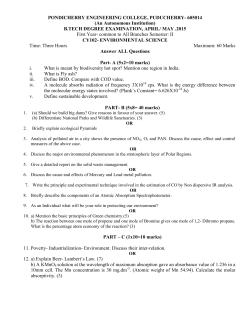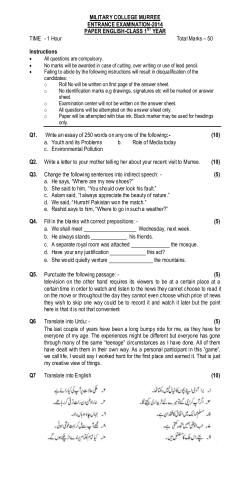
Geo Technical Engineering Model paper
INSTITUTE OF ENGINEERS SRI LANKA – COLLEGE OF ENGINEERING ADVANCED DIPLOMA – STAGE II GEOTECHNICAL ENGINEERING – CE4003 NOVEMBER – 2014 MODEL PAPER Answer 5 Questions only Question 01 I. A series of consolidated undrained tests were carried out on samples of overconsolidated clay. The results are tabulated below (All values being in kPa). Table 01 σ3 σ1 Pore pressure (u) 100 510 -65 200 720 -10 400 1120 80 520 1580 100 a) Plot the general Stress-strain behaviour and pore pressure vs. axial strain behaviour for normally consolidated and overconsolidated clay. [4 Marks] b) Determine Effective cohesion (c’) and effective friction angle (ϕ’) for the clay by plotting the stress path. [4 Marks] c) Assuming the soil to be saturated, what are the maximum and minimum values of Skempton’s pore-pressure parameter (A) determined from the tests? [6 Marks] II. A vane 120 mm long and 80 mm diameter was pressed into soft clay at the bottom of a borehole. When the failure took place the torque applied was 50 kNmm. Subsequently, the vane was rotated rapidly so as to completely remould the soil. The remoulded soil sheared at a torque of 20 kNmm. Calculate the cohesion of the clay in the natural and remoulded states. Assume undrained shear strength is uniformly mobilized (β=2/3). [6 Marks] Question 02 The best method of analysing stability of slopes is to determine the factor of safety (Fs) a) Define factor of safety (Fs), factor of safety with respect to cohesion and factor of safety with respect to friction for a potential slope stability problem with the usual notation. [4 Marks] b) For the infinite slope with given in figure (Figure 02), determine: I. The factor of safety against sliding along the soil-rock interface. Given : β = 30o, γ = 15.5 kN/m3, ϕ’ = 20o, c’=15 kN/m2 and H = 2m [4 Marks] II. The critical height of slope. [4 Marks] Figure 01 c) A cut is to be made in a soil having γ=100 kN/m3, c’=500 kN/m2, and φ’=16.5. The side of the cut slope will make an angle of 35o with the horizontal. Considering Culmann’s method for plane surface analysis determine the depth of the cut slope that will have a factor of safety (Fs) of 2? [8 Marks] Question 03 During a laboratory consolidation test, the time and dial gauge readings obtained from an increase of pressure on the specimen from 50 kN/m2 to 100 kN/m2 are given here. Table 02 Time (min) 0 0.10 0.25 0.60 1.0 2.0 4.0 8.0 Dial Gauge reading (mm) 3.98 4.08 4.10 4.13 4.17 4.22 4.30 4.42 Time (min) 16.0 30.0 60.0 120.0 240.0 480.0 960.0 1440.0 Dial Gauge reading (mm) 4.57 4.74 4.92 5.08 5.21 5.28 5.33 5.39 a) Find the time for 50% primary consolidation (t50) using the logarithm of time method [6 Marks] b) Find the time for 90% primary consolidation (t90) using the square root of time method. [6 Marks] c) If the average height of the specimen during consolidation caused by this incremental loading was 22mm and it was drained at both the top and the bottom, calculate the coefficient of consolidation using t50 and t90 obtained from parts (a) and (b). [8 Marks] Question 04 A 15 ft high retaining wall with a vertical back face retains a homogeneous saturated soft clay. The saturated unit weight of the clay is 122 lb/ft3. Laboratory tests showed that the undrained shear strength, cu, of the clay is equal to 350 lb/ft2. a) Make the necessary calculations and draw the variation of Rankine’s active pressure on the wall with depth. [4 Marks] b) Find the depth up to which a tensile crack can occur. [4 Marks] c) Determine the total active force per unit length of the wall before the tensile crack occurs. [6 Marks] d) Determine the total active force per unit length of the wall after the tensile crack occurs. Also, find the location of the resultant. [6 Marks] Question 05 The lowest part of a structure generally is referred to as the foundation. Its function is to transfer the load of the structure to the soil on which it is resting. Spread footings and mat foundations are generally referred to as shallow foundations. a) Define Ultimate bearing capacity and allowable bearing capacity [4 Marks] b) Give the general bearing capacity equation and describe different factors used in the equations with their usual notations. [4 Marks] c) What is the eccentricity of a foundation? How the bearing capacity equation is is modified for a one-way eccentric case. [4 Marks] d) A rectangular footing 1.5 m x 1 m is shown in Figure. Determine the magnitude of the gross ultimate load applied eccentrically for bearing capacity failure in soil. (Necessary Tables are given in Annex A) [8 Marks] Figure 02 Question 06 For most major structures, adequate subsoil exploration at the construction site must be conducted. a) List five purposes of a subsoil Exploration. [2 Marks] b) Explain the wash boring method using a detailed sketch. [2 Marks] c) What are the common sampling methods used in geotechnical investigations. [4 Marks] d) Describe the standard penetration test and what is meant by the standard penetration number (N). [4 Marks] e) Following are the results of a standard penetration test in sand. Determine the corrected standard penetration numbers, at various depths. Note that the water table was not observed within a depth of 35 ft below the ground surface. Assume that the average unit weight of sand is 110 lb/ft3. Use Skempton’s equation for the calculations. C_N= 2⁄(1+〖σ'〗_0 ) calculations. calculations. ⁄ [8 Marks] Table 03 Depth, z (ft) 5 10 15 20 25 N60 8 7 12 14 13 Question 07 Pile and drilled shaft foundations are considered as deep foundations and used for heavier structures when great depth is required for supporting the load. a) Classify piles based on function, material and method of installation. [3 Marks] b) Define the point bearing resistance (Qp) and skin resistance (Qs). [3 Marks] c) Explain pile load test and its uses using a neat sketch. [4 Marks] d) Consider a 15-m long concrete pile with a cross section of 0.45m x 0.45m fully embedded in sand. For the sand, given: unit weight, =17 kN/m3; and soil friction angle=350. Estimate the ultimate point with each of the following: I. Meyerhof’s method II. Vesic’s method III. The method of Coyle and Castello IV. based on the results of parts a, b, and c, adopt a value for Qp [10 Marks] Table 04: Bearing Capacity factors Table 05: Meyerhof’s Shape, Depth, and Inclination factors for a Rectangular Footing
© Copyright 2025









